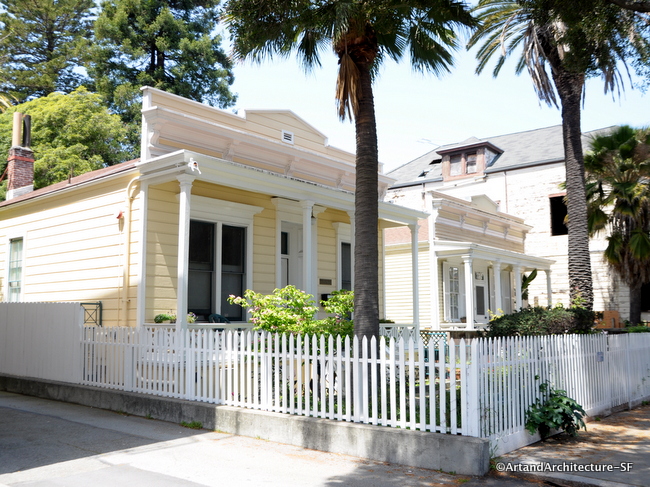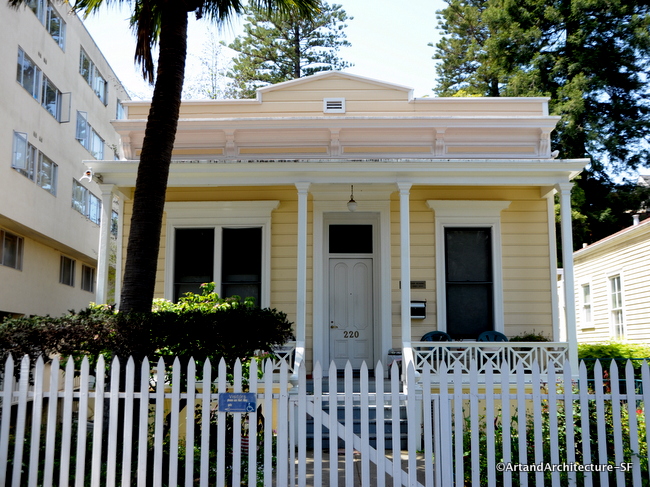214-220 Dolores
Mission District
Not far from Mission Dolores are a pair of homes considered to be the oldest in the Mission District and among some of the oldest in San Francisco: 214 and 220 Dolores Street.
The Mission District, originally Mission San Francisco de Asis, was the sixteenth in a chain of twenty missions stretching from San Diego to San Francisco. Mission San Francisco de Asis is affectionately called Mission Dolores after the lagoon the mission was first built on in 1776. At that time California was a part of Spain.
In 1821 Mexico achieved independence from Spain and annexed California. One of the first acts of the newly independent Mexican congress was to give the California governor the right to distribute land grants to private citizens. All a gentleman had to do to receive this generous gift was show that 1) he was a loyal and reliable Catholic citizen, and 2) he would map out his claim, build fences and build a house on his property. These grants were very large and sometimes ambiguous. (Today modern historians have a difficult time determining actual borders of these land grants.)
 Mission de Asis 1856 (Photo credit: San Francisco Public Library)
Mission de Asis 1856 (Photo credit: San Francisco Public Library)
It is thought that 214 and 220 Dolores were part of the Francisco Guerrero land grant, parceled in the early 1830s to both native “Californios” and foreign-born Mexican citizens. The parcels at 214 and 220 came into the hands of Torbio Tanforan and his wife Maria de los Angeles Valencia in 1896.
Torbio, a Chilean by birth, and his wife Maria, a native Californian, lived with their large family on a farm down the peninsula in what is now San Bruno. Their name is also associated with the Tanforan Race Track, now a shopping mall bearing their name. Torbio was the grandson-in-law of Jose Antonio Sanchez, the grantee of the Buri Buri Land Grant, where the race track was located.
It is thought that the Tanforans built 214 and 220 Dolores as farm houses. 214 was built first, and 220 followed a year or so later. The homes are simple frame structures with classic revival facades (an architectural movement based on the use of pure Roman and Greek forms in the early 19th century). Their false fronts, full width porches with square posts, and four-over-four window sashes (four panes of glass on the top frame and four panes of glass on the bottom frame of a double hung window) are common features of the 1890s. The deep-set backyard, another feature of that era, holds a carriage house that contained a Tanforan-owned carriage until 1940.
The houses were originally inhabited by the Tanforans’ daughter Mary and were handed down from sister to sister until 1952. It is not known if Torbio and Maria ever lived in them. They both died in San Francisco in 1884 and were buried in Mission Dolores; the home address listed on their obituary was Well Street.
In 1995, 220 Dolores was purchased by Dolores Street Community Services. It opened as a residential care facility for homeless men and women living with disabling HIV and AIDS. Originally the home was called Hope House, but was renamed when a neighbor (Richard M. Cohen)-who died of AIDS-bequeathed a significant portion of the funds for the renovation. Renovation was not an easy task, as 220 Dolores was already designated San Francisco Landmark #68. The architects took great care in maintaining the façade, and yet were able to add a lower floor, allowing the home to handle up to 10 residents at a time.
In 2002, 214 was repurposed as a home for drug and alcohol addicts in need. 214 Dolores is San Francisco Landmark #67.
If you are in the neighborhood, take a stroll past these two lovely homes, enjoy the gardens, and marvel at a time in San Francisco real-estate history when front porches, picket fences and expansive gardens were the norm.
 Mission Dolores in the 1800s (Photo credit: San Francisco Public Library)
Mission Dolores in the 1800s (Photo credit: San Francisco Public Library)



They are quite lovely and it is good they have been saved and upgraded.